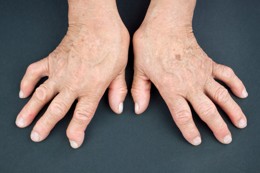Swan neck deformity is a condition where joints in the fingers are affected, causing them to bend in an awkward position. Let us have a look at some of the causes and treatment options available for this medical condition.

The ligaments, muscles, and tendons in a finger help in their movement and proper positioning. When an injury or disease affects any of these structures, it causes problems with finger alignment and function. In individuals with swan neck deformity, the middle joint of a finger remains in the hyperextended position, and the joint near the fingertip remains in the flexed position. The affected person is not able to fully straighten out his/her fingers. This is a permanent condition that is caused by injury or inflammatory conditions like rheumatoid arthritis.
Fingers are made up of three phalanges, and the two joints between the adjacent phalanges are called interphalangeal joints. Each finger joint can be straightened out with the help of tendons that are called extensor tendons. They are present on the backside of the bones in the forearms. These extensor tendons become extensor hoods when they reach the finger, and are connected to bands of tissues called ligaments. They help in balancing the motion of the finger joints. The strongest ligament is the volar plate that helps in straightening of the middle joint, and prevents its hyperextenxion. When the volar plate becomes weak or loses its ability to straighten up the joints, it leads to deformed fingers.
Causes
A hyperextended middle knuckle or proximal interphalangeal (PIP) joint, and a flexed distal interphalangeal (DIP) joint, leads to deformity. One of the most common causes is rheumatoid arthritis (RA), wherein chronic inflammation affects the PIP joint. This stretches the volar plate causing it to become weak. Soon, the PIP joint becomes loose, and bends into hyperextension. This causes the extensor tendon to shift out of place. When this happens, the DIP joint is affected, and it enters into a flexed position.
Other causes of this deformity include mallet fingers and Ehlers-Danlos Syndrome. In mallet fingers, the volar plate loses it ability to extend and straighten the DIP joint. This disrupts the function of extensor muscles, thus causing the DIP joints to flex. The ligaments on the top of the finger are torn at the distal end, and they tend to apply more force, leading to hypertension of PIP joint.
Those with Ehlers-Danlos Syndrome have loose or lax joints. This causes the fingers to bend backwards, and have hyperflexibility.
Symptoms
The PIP joint is in hypertension, that is, it is excessively bent backwards. The DIP joint is in the flexion position, that is, bent towards the palm. The fingers get a typical shape resembling the neck of a swan. In severe cases, one needs to use the other hand to straighten out the fingers, or close the fist.
Treatment
The treatment includes non-surgical as well as surgical options. When the PIP joint is supple and not stiff, the doctor will begin with a non-surgical treatment. This includes visit to occupational therapists who will try stretching, messaging, joint mobilization, and other techniques to correct the imbalances, and restore the finger alignment.
There are splints that help in keeping the PIP joints in line. These splints prevent the fingers from moving into hypertension. The new designs of splints look like jewelry rings, and are made from stainless steel, sterling silver and even gold. So, you can wear them as part of your deformity treatment, as well as flaunt them as a fashion accessory.
If six weeks of physical therapy and splints do not give the desired results, the doctors may suggest surgery. These surgeries include soft tissue repair, PIP joint arthroplasty, and joint fusion. The doctor will decide which surgery suits your condition. After surgery, one will be required to wear finger splints or braces, and undergo physical therapy. The therapy sessions continue for 3-6 months after the surgery.
Disclaimer: This Buzzle article is for informative purposes only, and should not be used as a substitute for professional medical advice.


 The ligaments, muscles, and tendons in a finger help in their movement and proper positioning. When an injury or disease affects any of these structures, it causes problems with finger alignment and function. In individuals with swan neck deformity, the middle joint of a finger remains in the hyperextended position, and the joint near the fingertip remains in the flexed position. The affected person is not able to fully straighten out his/her fingers. This is a permanent condition that is caused by injury or inflammatory conditions like rheumatoid arthritis.
The ligaments, muscles, and tendons in a finger help in their movement and proper positioning. When an injury or disease affects any of these structures, it causes problems with finger alignment and function. In individuals with swan neck deformity, the middle joint of a finger remains in the hyperextended position, and the joint near the fingertip remains in the flexed position. The affected person is not able to fully straighten out his/her fingers. This is a permanent condition that is caused by injury or inflammatory conditions like rheumatoid arthritis.